38 deviations from the ideal gas law worksheet answers
This graph shows how when you increase pressure, gasses pretty quickly deviate from the Ideal Gas Law: When we increase the pressure, PV/RT, which should equal one (PV = nRT, and with 1 mol of ideal gas, PV = RT), but these gases deviate from one. Image Courtesy of AskIITians Correcting the Ideal Gas Law using the Van der Waals Equation
Deviations From The Ideal Gas Law Worksheet Answers In previous units weve learned all about intramolecular forces things like how atoms are … Adjectives Good Better Best Worksheets
Gas Law Problems Worksheet Hour: _____ 1. A sample of air at 742 mm Hg and 28.5 °C occupies 12.48 L. The conditions are changes to 785 mm Hg and 42.6 °C. (Assume that the number of molecules remains constant.) a. Solve the Ideal Gas Law for the three variables in this problem. b. Find the new volume. 2.

Deviations from the ideal gas law worksheet answers
(a) From the standpoint of the kinetic-molecular theory, discuss briefly the properties of gas molecules that cause deviations from ideal behavior. (b) At 25°C and 1 atmosphere pressure, which of the following gases shows the greatest deviation from ideal behavior? Give two reasons for your choice. CH4 SO2 O2 H2
Download Free Ideal Gas Law Worksheet With Answers Ideal Gas Law Worksheet With Answers Right here, we have countless ebook ideal gas law worksheet with answers and collections to check out. We additionally pay for variant types and plus type of the books to browse.
Summary of Gas Laws: The Ideal Gas Law {R has other values if the units are changed. {R = 8.314 J/mol K zUse this value in thermodynamics. {R = 8.314 kg m2/s2 K mol zUse this later in this chapter for gas velocities. {R = 8.314 dm3 kPa/K mol zThis is R in all metric units. {R = 1.987 cal/K mol zThis the value of R in calories rather than J.
Deviations from the ideal gas law worksheet answers.
Chemistry Chemistry questions and answers Deviations from the Ideal Gas Law All real gases deviate to some extent from the behavior of perfect gases. At standard conditions, the density of 0(g) is 0.0014290 g/mL, that of H2(g) is 0.00008988 g/ml, and that of CO2(g) is 0.0019769 g/mL.
Correct answer: 200 K and 10 atm. Explanation: The ideal gas law assumes the gas particles are non-interacting and small relative to the size of their container. At 200K (lowest temperature in the list, and the highest pressure). This gives Ar the most time to interact due to molecular speeds and the high pressure implies the molecular size is ...
3 Gas Laws Interactions of Matter 5 11 3 wks 9-11 Gas Law Problems X Maxwell-Boltzman POGIL X Deviations from the Ideal Gas Law POGIL X Gas Law Stoich Problems X BIG IDEAS Phase Diagrams of CO 2 X Big Idea 2: Chemical and physical properties of materials ... Rate Law Problems Worksheet #1 X Rate-Law Expressions Worksheet #2 X
3. Use the Ideal Gas Law to calculate the pressure of the oxygen gas in Tank A. Enter that value in the Model I table. P (JO OOL rnòl 4. Use the Ideal Gas Law to ca cu ate t e pressure o e nitrogen gas in Tank Enter that value in the Model I table, 201K e — O a-tvvn 5.
Deviations from the Ideal Gas Law Does the Ideal Gas Law accurately calculate the pressure of a gas? Why? The equation PV = nRT, otherwise known as the Ideal Gas Law, is a powerful tool. A scientist can predict the pressure, volume, number of moles or temperature of a gas when the other variables are measurable. But how accurate is the ...
Combined Gas Law Problems Worksheet Answer Key. admin June 7, 2019. Some of the worksheets below are Combined Gas Law Problems Worksheet Answer Key, Gas Laws Worksheet : Boyle's Law Problems, Charles' Law Problems, Guy-Lussac's Law, Avogadros Law and Molar Volume at STP , Combined Gas Law Problems, …. Once you find your document (s ...
At what conditions (pressure vs temperature), do the laws of ideal gases deviate? usually ideal gases occur in high temp and low pressure (think of phase diagram) so the opposite would cause deviations
Deviations from ideal gas behavior can be seen in plots of PV/nRT versus P at a given temperature; for an ideal gas, PV/nRT versus P = 1 under all conditions. At high pressures, most real gases exhibit larger PV / nRT values than predicted by the ideal gas law, whereas at low pressures, most real gases exhibit PV / nRT values close to those ...
Law from PV = nRT to show the relationship between initial conditions n1 and V1 and final conditions n2 and V2. V/n = RT/P = const YV1/n1 = V2/n2 or n1/V1 = n2/V2 17. Avogadro's Law was an extension of an earlier observation of Gay-Lussac. Gay-Lussac's Law says that in reactions between gases at constant temperature and pressure, the volumes
The Results for. Pogil Answer Keys Chemistry Deviations From Ideal Gas Law. Function Worksheet.
Gas Laws Worksheet 1 Answer Key or 10 9 Real Gases Deviations From Ideal Behavior. The second section describes how much gas a car can hold at one time. This part is confusing and can take a long time to figure out for a child. It would be better if the parent spent a little bit of time working through this section.
This quiz and attached worksheet will help gauge your understanding of the deviation from the ideal gas laws. Gas molecules and particles are some quiz subjects. Quiz & Worksheet Goals Use these...
Ideal Gas Law Worksheet PV = nRT Use the ideal gas law, "PerV-nRT", and the universal gas constant R = 0.0821 L*atm to solve the following problems: K*mol If pressure is needed in kPa then convert by multiplying by 101.3kPa / 1atm to get R =8.31 kPa*L / (K*mole)
3.6 Deviations from Ideal Gas Law. Return to Topic List. 🔐 The page below is only for chemdunn subscribers only. Access ALL problem sets, answer keys and additional resources found on chemdunn. Gain access for the whole school year now here.
Jun 17, 2021 · Learning Objectives. To recognize the differences between the behavior of an ideal gas and a real gas; To understand how molecular volumes and intermolecular attractions cause the properties of real gases to deviate from those predicted by the ideal gas law.
Information (Ideal Gas Law) For any sample of gas under ideal conditions, the relationship between the amount of gas in moles (n) and its temperature, pressure, and volume is given by the relationshipPV = nRT in which R is the gas constant, with a value of 0.08206 L@atm/K@mol.When using this value of R, volume must be in liters, temperature must be in degrees kelvin, and amount of gas must be in
The behavior of real gases requires the use of a modified equation. Understand the ideal gas law, examine gas behavior assumptions, the Van Der Waals equation, and the deviations from the ideal ...
Deviations from the ideal gas law worksheet answers. Cities states and countries all have different laws. Lets start with a 224 L container. In this unit we dive deep into what happens when you put a bunch of molecules or atoms but mostly molecules together. Give the units for each variable. The deviation also varies from gas to gas.
View Homework Help - HW1_CHEM102_Answers.pdf from CHEM 102 at Qatar University. Home Work 1 CHEM102 Chapter 5: 5.8. Deviation from ideality Detailed answers of HW#1 1. Deviations from the ideal gas
In this unit, we dive deep into what happens when you put a bunch of molecules (or atoms, but mostly molecules) together. We begin with a look at intermolecular forces and the states of matter, then move into gases and solutions.This unit is super exciting😆 because there are tons of real-world, out of lab experiences you have with these concepts EVERY DAY😲 and we'll come to learn all ...
Lowering the temperature of a system causes deviations from the ideal gas law. Explain. The two factors that cause deviation from ideal behavior are an increase in attractive forces between particles and a reduction in free space relative to the volume of the container.
Deviations from Ideal Gas Law Behavior. The behavior of real gases usually agrees with the predictions of the ideal gas equation to within 5% at normal temperatures and pressures. At low temperatures or high pressures, real gases deviate significantly from ideal gas behavior. In 1873, while searching for a way to link the behavior of liquids ...
where: P is the pressure exerted by an ideal gas, V is the volume occupied by an ideal gas, T is the absolute temperature of an ideal gas, R is universal gas constant or ideal gas constant, n is the number of moles (amount) of gas.. Derivation of Ideal Gas Law. The ideal gas law can easily be derived from three basic gas laws: Boyle's law, Charles's law, and Avogadro's law.
Deviations from the Ideal Gas Law 1 Deviations from the Ideal Gas Law Does the Ideal Gas Law accurately calculate the pressure of a gas? Why? The equation PV = nRT, otherwise known as the Ideal Gas Law, is a powerful tool. A scientist can predict the pressure, volume, number of moles or temperature of a gas when the other variables are measurable. But how accurate is the calculated value?



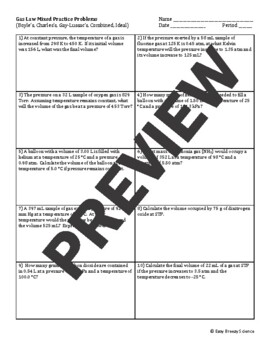







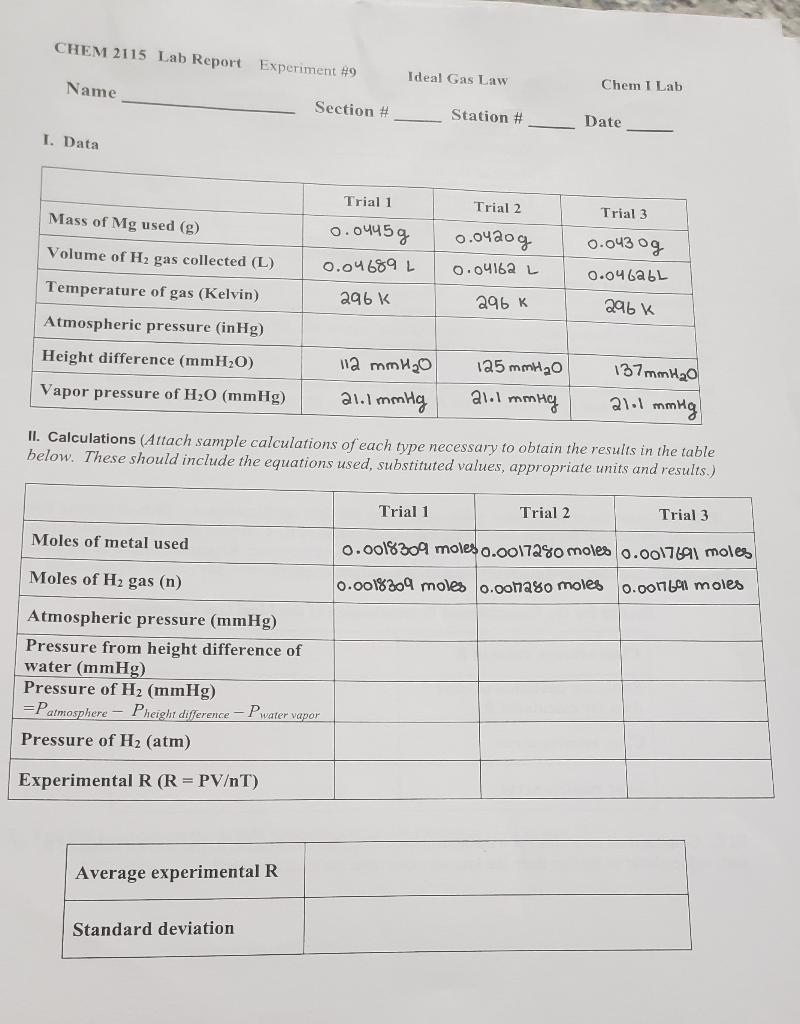


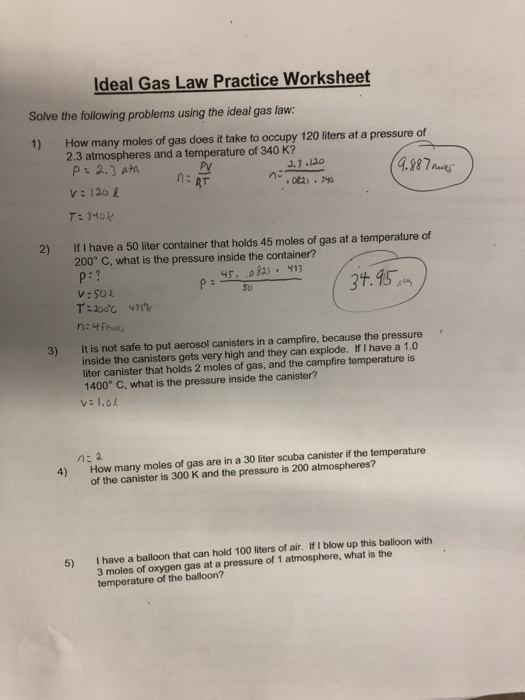

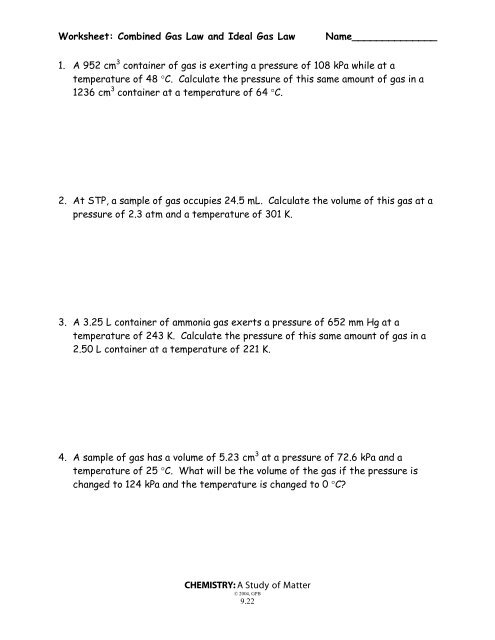


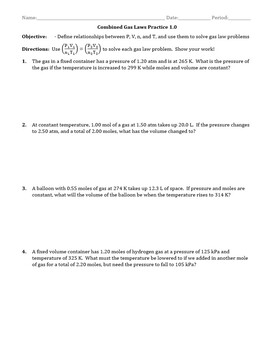













0 Response to "38 deviations from the ideal gas law worksheet answers"
Post a Comment